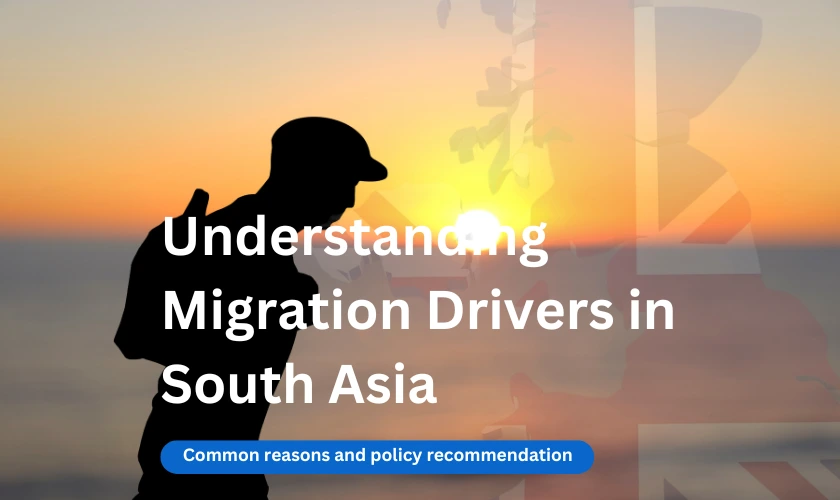South Asia, home to over 1.8 billion people, has one of the highest migration rates globally. According to the International Organization for Migration (IOM, 2020), millions of South Asians migrate each year, seeking economic opportunities, safety, or educational advancement. In the United Kingdom, the 2021 Census reported approximately 1.45 million individuals of Indian origin, 1.17 million of Pakistani origin, and 451,500 of Bangladeshi origin, reflecting substantial migration from South Asia to the UK over the decades (Minority Rights, 2023).
Common Reasons for Migration in South Asia
Migration from South Asia is driven by several critical factors:
- Economic Opportunities and Career Advancement: Economic hardship is a significant driver of migration in South Asia. Limited job opportunities push individuals from countries like India, Pakistan, and Bangladesh to seek employment abroad, including in the UK, where they often earn higher wages in sectors such as healthcare, information technology, and engineering (World Bank, 2018; De Haas, 2010). For instance, the UK has seen an increase in work-related arrivals from non-EU countries, particularly India, where professionals aim to fill roles in the health and social care sectors (Financial Times, 2023).
- Political Instability and Conflict: Political tensions and conflicts, particularly in Afghanistan and parts of Pakistan, often lead to forced migration. For example, the Afghan conflict has resulted in millions of refugees seeking safety in countries such as Pakistan and Iran (UNHCR, 2020).
- Educational Aspirations: Many South Asian students migrate for higher education, aiming to study in top universities abroad due to limited advanced training opportunities at home. The UK remains a popular destination, with significant numbers of Indian and Pakistani students pursuing degrees in engineering, medicine, and business (Beech, 2018).
- Family Reunification and Support: Family is a strong motivator for migration within South Asia, where many move to join relatives abroad. In countries with large diaspora communities, such as Canada or the UK, family reunification is a major pathway for migration (IOM, 2022).
- Environmental and Climate Change Factors: South Asia faces severe environmental challenges, including rising sea levels, droughts, and extreme weather. Bangladesh, for instance, sees high rates of internal and cross-border migration due to frequent flooding and climate-related displacement (IOM, 2020).
While these factors provide strong motivations for migration, it’s crucial to consider whether migration is the most appropriate response to these challenges.
Is Migration the Right Solution?
While migration can open doors to new opportunities, it’s not always the only solution. Before deciding to migrate, it’s important to evaluate whether challenges can be addressed within South Asia, avoiding the financial and emotional strain of moving abroad. In many cases, internal solutions may provide stability without the upheaval of international migration (IOM, 2022; Home Office UK, 2022).
For example:
- Economic Hardship: Financial struggles don’t always require international migration. Moving to a nearby urban centre within one’s home country can offer job opportunities. Many Indians, for example, find work in urban hubs like Mumbai or Delhi, reducing the need for overseas migration (De Haas, 2010).
- Career Development: Feeling stuck in a job is common, but further education or skill development domestically may be effective. India’s Skill India initiative, for instance, offers vocational training that helps individuals build careers within the country without needing to migrate internationally (Beech, 2018).
- Political or Social Challenges: Local and national organizations across South Asia offer support for individuals facing political or social challenges. NGOs in Pakistan, for example, provide legal aid and advocacy for marginalized groups, addressing issues that might otherwise prompt migration (Freedom House, 2021).
In many cases, internal solutions may offer sustainable alternatives to migration, allowing individuals to avoid the complexities of settling in an unfamiliar country. However, for those facing severe challenges such as persecution or life-threatening situations, migration may be necessary to ensure safety and stability (UNHCR, 2020).
When Migration Becomes Necessary
For individuals facing unresolvable issues, migration may be essential. Many South Asians have been forced to migrate due to political conflicts or natural disasters. Afghan refugees, for example, continue to seek refuge in neighboring countries like Pakistan to escape instability. In these cases, migration is essential for personal safety, freedom, and the opportunity to rebuild lives away from conflict (Freedom House, 2021; UNHCR, 2020). However, migration comes with challenges. Navigating complex immigration laws, cultural adaptation, and employment in a new country are all factors to consider carefully before making this decision (IOM, 2022).
Policy Recommendations
To support individuals in making informed migration decisions, governments and organizations in South Asia and destination countries can adopt targeted policies that reduce migration pressures and create safer migration pathways:
- Economic Development and Job Creation: Investing in local industries and job training can reduce economic migration. In Bangladesh, for instance, initiatives to support garment production have created employment opportunities within the country, reducing reliance on migration for economic stability (World Bank, 2018; Home Office UK, 2021).
- Accessible Vocational Training: Providing high-quality vocational training within South Asia, particularly in high-demand fields such as healthcare, IT, and engineering, can offer people viable alternatives to international migration. India’s Skill India program is a prime example of empowering people with in-demand skills domestically (De Haas, 2010; Home Office UK, 2022).
- Promoting Political Stability and Social Support: Programs that enhance community resilience, rule of law, and social support can reduce the need for migration. Community initiatives in Sri Lanka, for example, have helped reduce internal migration by creating safer environments and social stability (Freedom House, 2021).
- Safe and Accessible Migration Pathways: For those who need to migrate, governments in destination countries can create streamlined visa processes and provide integration support to facilitate cultural adaptation. The UK has introduced initiatives to better support migrant workers’ rights and well-being (Home Office UK, 2022).
Recognizing that migration is not always the best solution and promoting local alternatives can help South Asians make informed decisions about their futures.
Conclusion
Migration is a life-altering decision with both challenges and rewards. In South Asia, factors such as economic hardship, educational aspirations, and safety concerns drive millions to migrate each year. By fostering policies that support local development and offering alternatives to migration where possible, countries can help reduce the pressures that lead to migration while ensuring safe and supportive pathways for those who choose or need to migrate. Ultimately, thoughtful consideration of individual circumstances and a comprehensive understanding of the options can lead to a more positive migration experience for South Asians.
References
Beech, S. E., 2018. International student mobility: An identity beyond the field of education. Journal of Research in International Education, 17(1), pp.25-39.
De Haas, H., 2010. Migration and development: A theoretical perspective. International Migration Review, 44(1), pp.227-264.
Financial Times, 2023. Record numbers from India move to UK for work. Financial Times. [online] Available at: https://www.ft.com/content/67cfd5c4-e79f-4f48-9226-dc592aa6aa74 [Accessed 4 Nov. 2024].
Freedom House, 2021. Freedom in the World 2021: Democracy under siege. [online] Available at: https://freedomhouse.org/report/freedom-world/2021/democracy-under-siege [Accessed 4 Nov. 2024].
Home Office UK, 2021. Pre-migration Programs and Support for Migrants. [online] Available at: https://www.gov.uk [Accessed 4 Nov. 2024].
Home Office UK, 2022. Visa Process Simplification and Migrant Assistance. [online] Available at: https://www.gov.uk [Accessed 4 Nov. 2024].
International Organization for Migration (IOM), 2020. World Migration Report 2020. Geneva: IOM.
International Organization for Migration (IOM), 2022. Migration policy frameworks in Africa. [online] Available at: https://www.iom.int/migration-policy-frameworks-africa [Accessed 4 Nov. 2024].
Minority Rights, 2023. South Asians in the UK. [online] Available at: https://minorityrights.org/communities/south-asians/ [Accessed 4 Nov. 2024].
UNHCR, 2020. Global trends: Forced displacement in 2020. [online] Available at: https://www.unhcr.org/globaltrends2020/ [Accessed 4 Nov. 2024].
World Bank, 2018. Moving for prosperity: Global migration and labor markets. [online] Available at: https://www.worldbank.org/en/research/brief/moving-for-prosperity-global-migration-and-labor-markets [Accessed 4 Nov. 2024].



